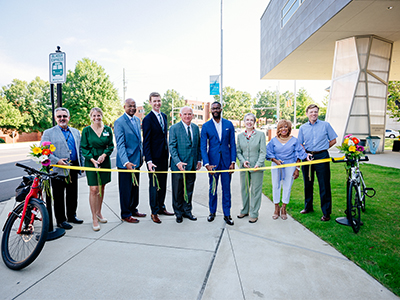The University of Alabama at Birmingham hosted a ribbon-cutting to celebrate the newly completed 10th Avenue Road Diet project Thursday, Aug. 1, in front of the Abroms-Engel Institute for the Visual Arts facility.
“This project improves pedestrian safety and traffic flow, and — with its bike lanes and additional green space — promotes sustainability and further beautification of our campus and our city,” said Ray L. Watts, UAB president. “These are shared successes for UAB and our community, and we are grateful for the longtime partnership with the City of Birmingham that is stronger than ever.”  From left Allen Bolton, Julie Price, Andre Davis, James Fowler, President Ray L. Watts, Mayor Randall L. Woodfin, Councilor Valerie Abbot, Councilor Wardine Alexander and Councilor Darrell O'Quinn
From left Allen Bolton, Julie Price, Andre Davis, James Fowler, President Ray L. Watts, Mayor Randall L. Woodfin, Councilor Valerie Abbot, Councilor Wardine Alexander and Councilor Darrell O'Quinn
The yearlong redesign of 10 city blocks along 10th Avenue South between Eighth and 18th streets south has changed the flow of traffic to be more mindful of pedestrians and cyclists by including brightly painted bicycle lanes and crosswalks. In some areas, lanes of traffic were removed to put in bike and turn lanes. The project was in collaboration with the City of Birmingham, which adopted a Complete Streets ordinance last year.
Through a process known as a road diet, UAB narrowed the four-lane road to three — one eastbound, one westbound and a center turn lane — to create a new cycling lane on each side.
“Road diets generally slow vehicular traffic, which makes it safer for our folks to walk while also providing opportunities for alternative modes of circulation, such as biking and walking,” said Geoff Boyd, director in UAB Facilities Planning Design and Construction.
The project also improved the 10th Avenue intersections at 13th and 17th streets in UAB’s cultural arts corridor.
Keynote speakers for the ribbon-cutting included Watts, City of Birmingham Mayor Randall L. Woodfin, Andre Davis, director of UAB Transportation, and James Fowler, director of the City of Birmingham Department of Transportation.